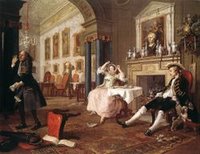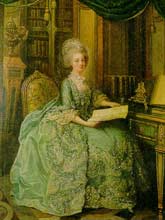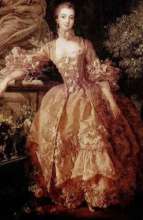Rococo fashion era

The Rococo style of art emerged in France in the early 18th century. It is characterized by opulence, grace, playfulness, and lightness in contrast to the heavier themes and darker colors of the earlier Baroque period.
The word Rococo was apparently a combination of the French rocaille, or shell, and the Italian barocco, or Baroque style. Because of Rococo love of shell-like curves and focus on decorative arts, some critics used the term to derogatively imply that the style was frivolous or merely fashion. Since the mid 19th century, though, the term has been accepted by art historians. While there is still some debate about the art historical significance of the style, rococo is now widely recognized as a major period in the development of European art.
As for fabric
 s, lightweight silks such as taffeta, satin and damask were chosen in light, pastel colours. Colours must not be too brilliant. Tastes were for large floral motifs at first, then favoured smaller motifs and finally, stripes sprinkled with sprigs. Solid colours were also popular throughout.
s, lightweight silks such as taffeta, satin and damask were chosen in light, pastel colours. Colours must not be too brilliant. Tastes were for large floral motifs at first, then favoured smaller motifs and finally, stripes sprinkled with sprigs. Solid colours were also popular throughout.A lady's clothing of the Louis Quinze (XV) era was marked by the hoop skirt which came into use around 1720, shaped like the baskets in which chickens were carried to marked and therefore called panier. In the corse of the following decades, it changed from funnel- via dome- and trapezium-shaped to square and finally to an oval dome shape. Over the panier went a skirt named jupe and over that the coat-like robe, similar to the baroque mantua. The gap in front was covered filled with a richly decorated stomacher. The sleeves were elbow length and bore wing-like cuffs, later (from c. 1750) they ended in flounces. At neckline and elbow, the lace trim of the shirt became visible. The French robe a.k.a. contouche had large so-called Watteau pleats which flowed elegantly down the back, which the English robe was a direct descendant of the mantua with sewn-d
 own back pleats.
own back pleats.At first, ladies apparently wore wigs only on rare occasions and preferred to have their own hair powdered and coiffed, decorated with a small bonnet or flowers, jewelery and bows. The use make-up, perfume, beauty spots and rich trimmings on dresses also started out relatively tame but picked up further into the century.
Men's fashion did not change much during the whole era. The justaucorps, waistcoats and breeches that had been introduced during the late baroque era were worn throughout, changing only slightly in shape. The coat skirts, for example, grew fuller until around 1740, then diminished and were cut away in front from around 1760. The waistcoat below became ever shorter until it only reached the hips. It was buttoned only in the stomach region (the coat left completely open) so that the shirt ruffles could be seen above. The cravat covered the neck.
 Thanks to
Thanks toMauritia.de

4 Comments:
what would the funtions of dress be for the rococo?
Awesome, way better than my blog www.pixie-pashion4fashion.blogspot.com I love your blog and its helped me alot with my textiles project thahnks :D
If you want to see a good modern interpretation of the Rococo style, look at the costumes the Japanese rock band Versailles -Philharmonic Quintet- wears. They're widely known for their use of the Rococo style in their manner of dressing, as well as having a very Baroque sound in their music. I call it a modern interpretation because they use bright, bold color--such as red and turquoise--and black, lots of black.
Another example of a modern interpretation of Rococo style would be Lolita fashion, widely popular in Japan. It focuses mainly on frivolous frills, creating a cute, delicate style. :3 My answer to Ashley's question: The function of the Rococo dress would be to show off one's assets - fiscal and physical! ;)
Post a Comment
<< Home